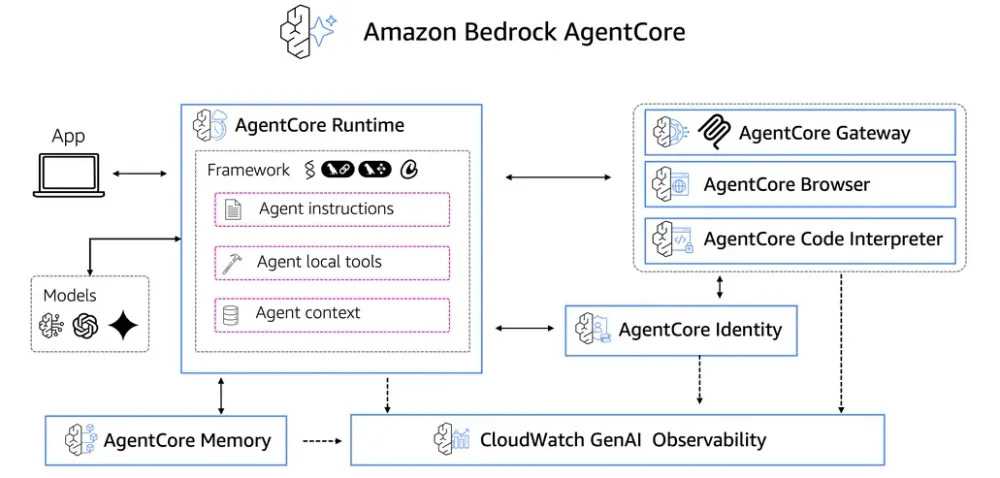Welcome to your journey into enterprise-grade AI agent deployment! You've made excellent progress through the foundational concepts of Amazon Bedrock, knowledge bases, and agent frameworks. Now, we're ready to take the next step: deploying production-ready agents using Amazon Bedrock AgentCore.
In this course, "Deploying Agents to AWS with Bedrock AgentCore", we'll explore how to build, secure, and scale AI agents for real-world enterprise applications. This opening lesson will introduce you to AgentCore's architecture and capabilities, setting the foundation for hands-on deployment in subsequent lessons. We'll cover AgentCore's modular services, understand how they solve enterprise challenges, and focus specifically on AgentCore Runtime as our primary deployment platform.
Amazon Bedrock AgentCore represents AWS's latest evolution in AI agent technology, announced in July 2025 at the AWS Summit New York. Unlike experimental AI applications, AgentCore is designed specifically for enterprise-grade production deployments, where scale, security, and reliability are paramount.
AgentCore enables developers to deploy and operate highly effective agents using any framework, model, or protocol. Whether you're working with LangGraph, CrewAI, or Strands Agents (which we explored in previous courses), AgentCore provides the infrastructure backbone to bring these agents into production environments. The platform is composable, meaning you can use its services independently or together based on your specific requirements.
Most importantly, AgentCore doesn't lock you into proprietary solutions; it enhances your existing open-source workflows with enterprise capabilities that would typically require months of custom infrastructure development.
Traditional AI agent development faces significant hurdles when transitioning from prototype to production. Teams often struggle with session management, where multiple users accessing the same agent can interfere with each other's conversations. Security becomes complex when agents need access to both internal systems and external APIs while maintaining proper authentication and authorization.
Memory management presents another challenge: agents need to remember context across conversations while efficiently handling both short-term dialogue state and long-term learned behaviors. Infrastructure scaling demands expertise in containerization, load balancing, and monitoring, which diverts focus from core agent logic.
AgentCore addresses these challenges through purpose-built services that handle infrastructure complexity, allowing developers to focus on agent intelligence rather than operational concerns. This architectural approach transforms agent development from a custom infrastructure project into a focused application development effort.
The following videos will provide you a general overview of AgentCore:
Amazon Bedrock AgentCore consists of seven modular services that work independently or together. AgentCore Runtime provides secure, serverless hosting with session isolation and extended execution support. AgentCore Identity manages authentication and authorization across multiple identity providers, while AgentCore Memory handles both conversational context and persistent knowledge.
AgentCore Gateway transforms existing APIs into agent-compatible tools, eliminating weeks of integration work. AgentCore Code Interpreter enables secure code execution in isolated environments, and AgentCore Browser provides cloud-based web automation capabilities. Finally, AgentCore Observability offers comprehensive monitoring through OpenTelemetry and CloudWatch integration.
Each service addresses specific enterprise requirements: Runtime ensures scalability and security, Identity provides seamless authentication, Memory enables context-awareness, Gateway simplifies tool integration, and Observability maintains operational visibility. Here's a simple diagram that describes how the different components of Bedrock AgentCore interact:

Throughout this course, we'll concentrate primarily on AgentCore Runtime, the foundational service that hosts and executes agent applications. Runtime distinguishes itself through session isolation, ensuring that each user's interactions remain completely separate, preventing data leakage and maintaining performance consistency.
The service supports extended runtime execution of up to 8 hours, accommodating complex workflows that traditional serverless functions cannot handle. Runtime automatically manages scaling, security, and protocol compatibility, supporting both HTTP and Model Context Protocol (MCP) communications.
What makes Runtime particularly powerful is its framework-agnostic approach; whether your agent is built with LangGraph, CrewAI, or custom Python code, Runtime provides consistent hosting capabilities. The service handles cold starts efficiently, maintains true session isolation, and includes built-in identity integration, addressing the core challenges of production agent deployment.
Enterprise organizations are already experimenting with and planning to leverage AgentCore for transformative applications. One of Latin America's largest banks and a pioneer of using Agentic AI to provide customers with hyper-personalized banking experiences, has planned to use Amazon Bedrock AgentCore services to expand possibilities and enable secure, scalable financial services transformation while ensuring compliance and meeting customer commitments at scale.
An innovative healthcare company is building the Healthcare Model Context Protocol (HMCP) on AgentCore Gateway, which automatically converts their existing APIs into MCP-compatible tools while scaling seamlessly as they grow. This provides the secure, flexible foundation needed to ensure AI agents can safely and responsibly interact with healthcare data, tools, and workflows while maintaining strict compliance and operational standards.
A notable marketing firm plans to leverage AgentCore to accelerate intelligent agent development for dynamic content creation and customer journeys, expecting to cut campaign build times by up to 30% and boost engagement metrics across key verticals. Meanwhile, a cloud company is experimenting with deploying agents using Bedrock AgentCore Runtime, built with Strands Agents, to allow their customers to scale AI capabilities while maintaining top-tier security and compliance standards for intelligent cloud content management.
These implementations and planned deployments demonstrate AgentCore's versatility across industries with stringent security, compliance, and performance requirements. The platform enables organizations to deploy AI agents that enhance customer experiences while maintaining enterprise-grade reliability and security standards.
Amazon Bedrock AgentCore transforms AI agent development from experimental prototyping to enterprise-grade production deployment. By providing modular, composable services that handle infrastructure complexity, security, and scaling, AgentCore allows developers to focus on building intelligent, effective agents rather than managing operational concerns. We've established the foundation for understanding AgentCore's architecture and capabilities, with particular emphasis on Runtime as our primary deployment platform.
In the upcoming practice section, you'll gain hands-on experience with AgentCore's core concepts and begin working directly with the platform. This practical foundation will prepare you for the advanced deployment techniques we'll explore throughout the remainder of this course.
